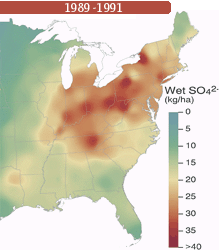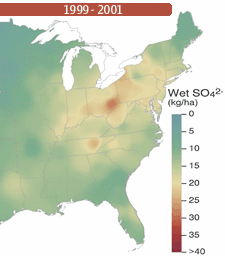Clear Skies
Cap and Trade Basics
You will need Adobe Acrobat Reader, available as a free download, to view some of the files on this page. See EPA's PDF page to learn more about PDF, and for a link to the free Acrobat Reader.
Related Information
Fact Sheet on Cap-and-Trade Programs (PDF, 2 pp., 50KB)
Emissions Cap and Trade and Hot Spots (PDF, 17 pp., 1.7MB)
How Does it Work?
The emissions cap – the total amount of pollution that sources can emit – is set to meet specific environmental goals.
- EPA distributes allowances equal to the cap amount. (For example, in the Acid Rain Program each allowance authorizes one ton of emissions).
- Sources have flexibility to choose how to meet their limits – by reducing their own emissions or purchasing allowances from other sources.
- Sources measure and report emissions, and must have sufficient allowances to cover their emissions; significant automatic penalties apply for noncompliance.
Instead of the government telling electricity generators precisely where and how to reduce their emissions – the old command-and-control approach – this market-based program tells the entire industry when and how much to reduce pollution by establishing a firm, maximum “cap” on emissions.
The banking aspect of the trading program creates incentives for electricity generators to reduce their emissions further and more quickly than the law requires. Electricity generators must hold an “allowance” for each ton of pollution they emit. The number of allowances that are distributed are reduced over time. Electricity generators must continually monitor and report their emissions.
Most importantly, these allowances can be traded
freely. This rewards companies that discover better ways to reduce
emissions by allowing them to sell unneeded allowances in the market.
Companies that cannot reduce emissions have the flexibility in this
market framework to buy additional allowances without undermining
air quality. This flexibility lets businesses determine the cheapest
way to reduce emissions while government determines the overall
emission cap at a level that guarantees air quality and that environmental
goals are met.
Why does it work?
- The cap and automatic penalties for noncompliance ensure that the environmental goal is achieved and maintained.
- The cap provides market value and certainty.
- Trading and banking allow companies to choose compliance options.
- Trading and banking minimize costs through compliance flexibility.
The cap ensures that the reductions are achieved and maintained
over time even as new power plants are built. The trading program
gives power plants the flexibility to choose how they meet their
target emission reductions, which minimizes compliance costs and
lowers consumer electricity prices.
Success achieved using this approach
- Near-perfect compliance – Compliance with the Acid Rain Program has been an unprecedented success (over 99%).
- Early reductions – Reductions in the early years of the program averaged 25% below allowable levels, resulting in early benefits to human health and the environment.
- Air quality improvement – Emission cuts resulted in air quality improvements over a broad area of the U.S. and significant reductions in acid rain.
- Cost savings – The Acid Rain Program cost 75% less than originally projected.
- Innovation – A monetary value for lower emissions creates the right incentives.
- Integrity – High accountability and transparency provide credibility.
- Support – The Acid Rain Program enjoys a high level of acceptance by environmental organizations and industry, and bipartisan Congressional support.
| Acid Deposition before the Acid Rain Program | Acid Deposition Currently | |
 |
 |
Cost savings – The acid rain cap and trade program passed by Congress in 1990 achieved reductions at two-thirds the cost of achieving the same reductions under a command-and-control system. This program reduced more pollution in the last decade than all other Clean Air Act command-and-control programs combined during the same period.
Innovation – Trading under the acid rain program created financial incentives for electricity generators to look for new and low-cost ways to reduce emissions and to do so early.
What about Hot Spots?
- Under the Acid Rain Cap and Trade Program, no “hot spots” (areas of heavy, localized emissions) have occurred nor any geographical shifting of emissions.
- The highest emitting sources reduced by the greatest amount.
- Several organizations, including the Environmental Law Institute, Environmental Defense and Resources for the Future, have conducted analyses of emissions trading under the Acid Rain Program and none have concluded that the Program resulted in hot spots.
- Trading occurs under a nationwide cap that represents a reduction in total emissions and improvements in regional air quality. The flexibility under a cap and trade system isn't about whether to reduce emissions, but about how to reduce them at the lowest possible cost.
- All areas of the country must continue to meet national ambient air quality standards.
